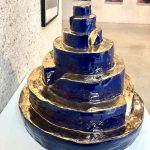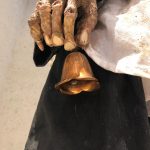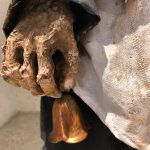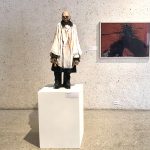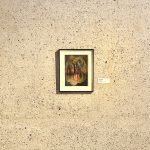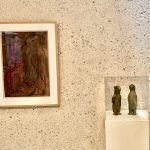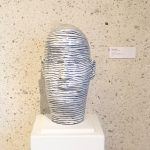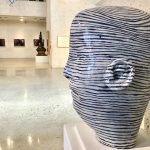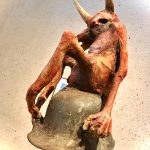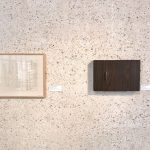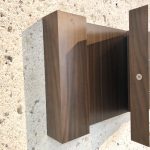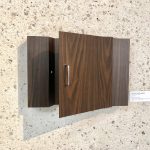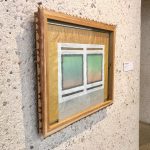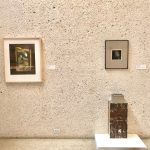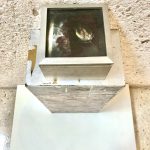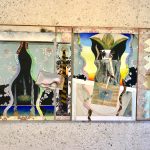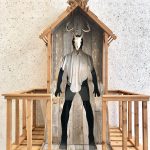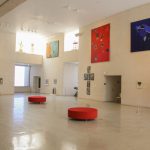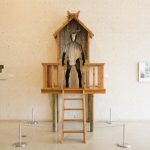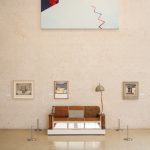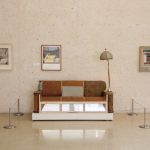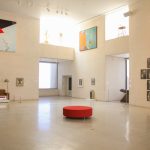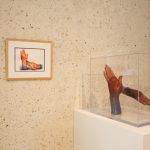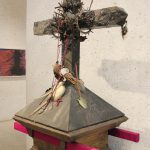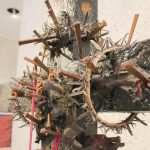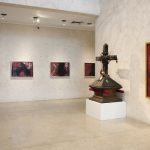04/29/2022 - 08/21/2022
Drawings,
Glass,
Painting,
Paper,
papier-mâché,
Photography,
Sculptures,
Wood
Singer and Ullberg Galleries
On view through August 21, 2022, in the Singer and Ullberg Galleries
Featuring works by: Judy Chicago, Danny O’Dowdy, Roy Fridge, Kathy Vargas, Sharon Kopriva, Michael Tracy, Richard Artschwager, Dee Wolff, and Tre Arenz
These nine artists have work that is at times a direct study for the final work. Judy Chicago (American b. 1939) first depicts her idea in a drawing, which later became the work as a dimensional sculpture, seen here in Study for Grand Hands of Choice and finally Grand Hands of Choice. The artist used her own left hand as the model, and with the aid of a glass fabricator increased the scale to the size she wanted which is much larger in scale. The colors she used appear in both the drawing, and in the finished three-dimensional work.
In the large-scale work of Divan, by Danny O’Dowdy (American 1938-2019) we see in the installation that the monoprint is displayed behind the sofa (also known as a divan) and depicts the subject of a dog atop the printed paper image. The sculptural version is devoid of any dog but instead includes a hand-drawn narrative applied directly to the wooden sofa. Together, his works make a statement about art and life and time spent together within nature and everyday life.
A great point of entry for sculptural works by Roy Fridge (American 1927-2007) is the way his works on paper describe his desire to make the work he does, and the adventure creating it has taken him. Seated Shaman Shrine/Museum Replica, 1992 and Coletto Creek Sampan and Sailing Scow, 1981-82 are results of these narratives. One is a replica of a shrine, the other a means to navigate the creeks and open water. He created both in order to engage with South Texas, and the wildness in the landscape. A former commercial film maker, Fridge was an artist whose life was as much his work as the resulting sculpture. Incredibly, he built his own house in Port Aransas, Texas.
At one time Kathy Vargas (American b. 1950) practiced as a documentary photographer taking photographs of Rock ‘n’ Roll musicians. Her work later evolved to become more personal, and more about her own life and observations. Broken Column, 1996 is a work presented in the form of a hand-colored silver gelatin print of six photographs incrementally showing the demise of her mother’s body as she struggled with her diminishing health. Vargas was given permission by her mother to take these photographs, and she hand colored each one of the body details portraying with subtlety a painfully beautiful ending to her mother’s life. In an adjacent installation Vargas created the photograph of a hand that hangs above a reliquary which inside presents the viewer with a rose, also hand colored and seemingly preserved in a glass and wooden box covered with gold and silver guild.
Sharon Kopriva (American b. 1948) has been making art for over 30 years, and in it she has investigated Pre-Columbian cultures in Peru, while visiting crypts and further examining her own Catholic faith. Most recently she has experienced forested nature in the Pacific Northwest. We can see in the two-dimensional work titled Islamic Shrine, 1997 how she incorporates the green forests using layers of collaging and painting, and thereby redefines her spiritual connection to the natural world. The work on paper employs the relief technique which layers her images of the forest as she creates depth and volume which allows the eye to view the depth of her imagery.
The work of Michael Tracy (American b. 1943) came into the art museum during its inaugural year in 1972, in an exhibition title bearing only his name: Michael Tracy. He is an artist who, like Roy Fridge chose to live somewhat remotely. In Tracy’s case, this was in San Ignacio, Texas, a very small colonial town between the Rio Grande River and U. S. Highway 83 where the population in the 2010 census was under 700 people and the predominant faith of the region is Catholic. It is between the artist’s fascination with the iconography of this religion, especially the crucifix, and the materiality of his medium that he finds his voice. The works on paper are Untitled and reference Passage Ritual Drawings. They are said to have been created on Corpus Christi Street, [here] in the city of Corpus Christi. Note: the Latin translation of Corpus Christi is the Body of Christ. Tracy incorporates ritual, as can be perceived in Cruz de la Paz Sagrada (Cross of the Sacred Peace) 1975.
Two works in this exhibition prominently feature the interest in and reputation of Richard Artschwager (American 1923-2013)for conceptual art, which is art about the idea. The line drawing and in a compressed way illustrates his talent as an illustrator . Door Window Table Basket Mirror Rug #32 is a vertical formatted series of drawings that on a single piece of horizontal white paper in black ink. It depicts what may have been viewed from what may have each been very close at hand, and yet, they are lines on a page. What is installed next to this linear drawing is a Formica wood-grained cabinet where the artist has created a whimsical idea of a cabinet, and yet when open reveals itself to not be a cabinet at all. This a work of sculpture, pure and simple.
Artist Dee Wolff (American b. 1948) attended the University of Houston in the 70’s and later attended the Glassell School of Art, which is the teaching institute of the Museum of Fine Arts, Houston. Wolff has been making images she calls Selah for over 30 years. Selah is an acronym for spiritual exploration of her own consciousness. She has said “I am interested in how human beings and cultures define their spiritual traditions. I am also interested in the symbolic mythology of both personal and organized religion…” Wolff also studied at the C.G. Jung Center in Houston and the Oomoto School of Traditional Art in Japan. Her work in gouache are depictions referencing the events of 9/11 in New York City.
Tre Arenz (American 1953-2003) training was in clay ceramics. During her life she conducted workshops and was commissioned by the City of San Antonio Convention Center, the City of Austin Art in Public Places, the Austin Zoo, and her work appears in many public and private collections. Her work in two and three dimensions is whimsical and yet poignant, referencing the human in the domestic of everyday. Interested in expanding what the boundaries of ceramics as a medium could be, Arenz she was influenced by the California Funk movement, and her work exhibits this playfulness.
Accessibility Information
Photo Restriction: Photography allowed in the exhibition (no flash, no tripods)
Touch Restriction: Non-touch exhibition
Exhibition Language(s): English
Potential Challenges for Visitors With:
- Specific Religious Beliefs – Artwork includes religious imagery
- Young Children – Artwork includes nudity
- Dyslexia – Artwork includes cursive handwriting
Other Notes:
Click here to read the handwritten journal entries in Roy Fridge’s works.
For questions or more information, please contact: clayton.reuter@tamucc.edu

